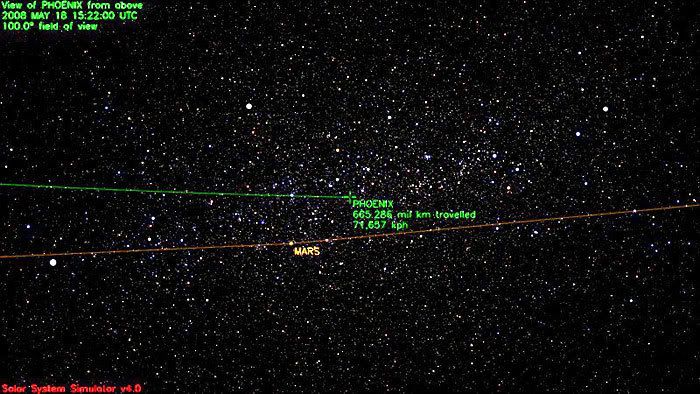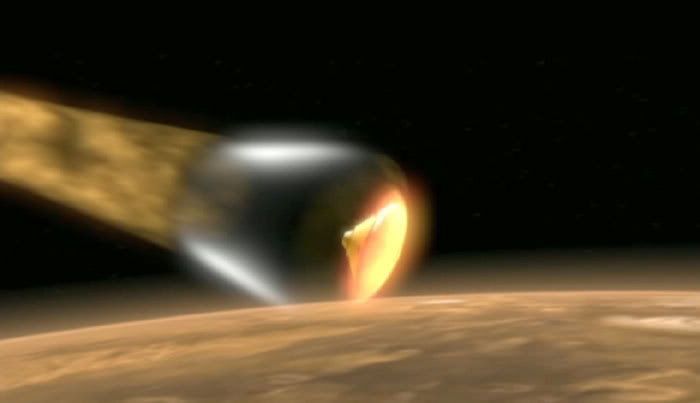
ABOVE: This image marks the path traveled by the Phoenix spacecraft as of 8:22 AM, Pacific Daylight Time, on May 18, 2008. It has flown a distance of 413 million miles since launch...at a speed of 44,523 miles per hour. Click here to view the official webpage showing where Phoenix is in space.
ONE WEEK FROM TODAY...
****
(Official Press Release)
WASHINGTON -- NASA's Phoenix Mars Lander is preparing to end its long journey and begin a three-month mission to taste and sniff fistfuls of Martian soil and buried ice. The lander is scheduled to touch down on the Red Planet May 25.
Phoenix will enter the top of the Martian atmosphere at almost 21,000 kilometers per hour (almost 13,000 mph). In seven minutes, the spacecraft must complete a challenging sequence of events to slow to about 8 kilometers per hour (5 mph) before its three legs reach the ground. Confirmation of the landing could come as early as 4:53 PM Pacific Daylight Time (7:53 PM Eastern Daylight Time).
"This is not a trip to grandma's house. Putting a spacecraft safely on Mars is hard and risky," said Ed Weiler, associate administrator for NASA's Science Mission Directorate at NASA Headquarters in Washington. "Internationally, fewer than half the attempts have succeeded."
Rocks large enough to spoil the landing or prevent opening of the solar panels present the biggest known risk. However, images from the High Resolution Imaging Science Experiment (HiRISE) camera on NASA's Mars Reconnaissance Orbiter, detailed enough to show individual rocks smaller than the lander, have helped lessen that risk.
"We have blanketed nearly the entire landing area with HiRISE images," said Ray Arvidson of Washington University in St. Louis, chairman of the Phoenix landing-site working group.
"This is one of the least rocky areas on all of Mars and we are confident that rocks will not detrimentally impact the ability of Phoenix to land safely."
Phoenix uses hardware from a spacecraft built for a 2001 launch that was canceled in response to the loss of a similar Mars spacecraft during a 1999 landing attempt. Researchers who proposed the Phoenix mission in 2002 saw the unused spacecraft as a resource for pursuing a new science opportunity.
Earlier in 2002, NASA's Mars Odyssey orbiter discovered that plentiful water ice lies just beneath the surface throughout much of high-latitude Mars. NASA chose the Phoenix proposal over 24 other proposals to become the first endeavor in the Mars Scout program of competitively selected missions. "Phoenix will land farther north on Mars than any previous mission," said Phoenix Project Manager Barry Goldstein of NASA's Jet Propulsion Laboratory, Pasadena, Calif.
"The Phoenix mission not only studies the northern permafrost region, but takes the next step in Mars exploration by determining whether this region, which may encompass as much as 25 percent of the Martian surface, is habitable," said Peter Smith, Phoenix principal investigator at the University of Arizona, Tucson.
The solar-powered robotic lander will manipulate a 2.35 meter arm (7.7 foot) to scoop up samples of underground ice and soil lying above the ice. Onboard laboratory instruments will analyze the samples. Cameras and a Canadian-supplied weather station will supply other information about the site's environment.
One research goal is to assess whether conditions at the site ever have been favorable for microbial life. The composition and texture of soil above the ice could give clues to whether the ice ever melts in response to long-term climate cycles. Another important question is whether the scooped-up samples contain carbon-based chemicals that are potential building blocks and food for life.
The Phoenix mission is led by Smith, with project management at JPL. The development partnership is with Lockheed Martin, Denver. International contributions are from the Canadian Space Agency; the University of Neuchatel, Switzerland; the universities of Copenhagen and Aarhus, Denmark; the Max Planck Institute, Germany; and the Finnish Meteorological Institute.

PHOENIX Blog Entries Archive:
May 8, 2007
July 28, 2007
August 3, 2007
August 4, 2007
August 8, 2007
October 25, 2007
April 11, 2008
April 25, 2008
May 1, 2008
May 11, 2008

No comments:
Post a Comment